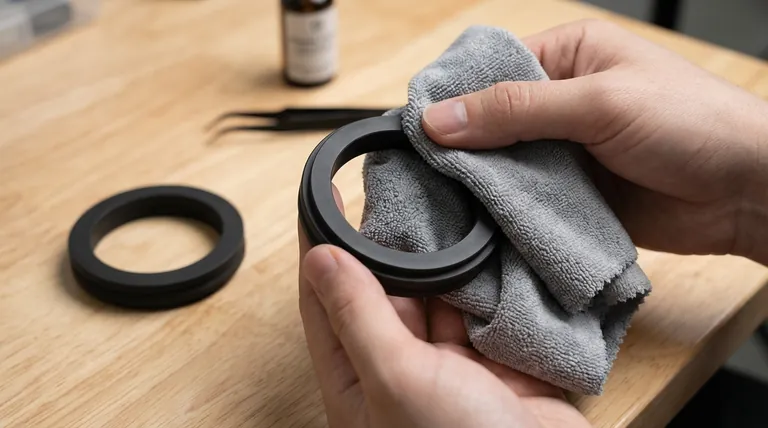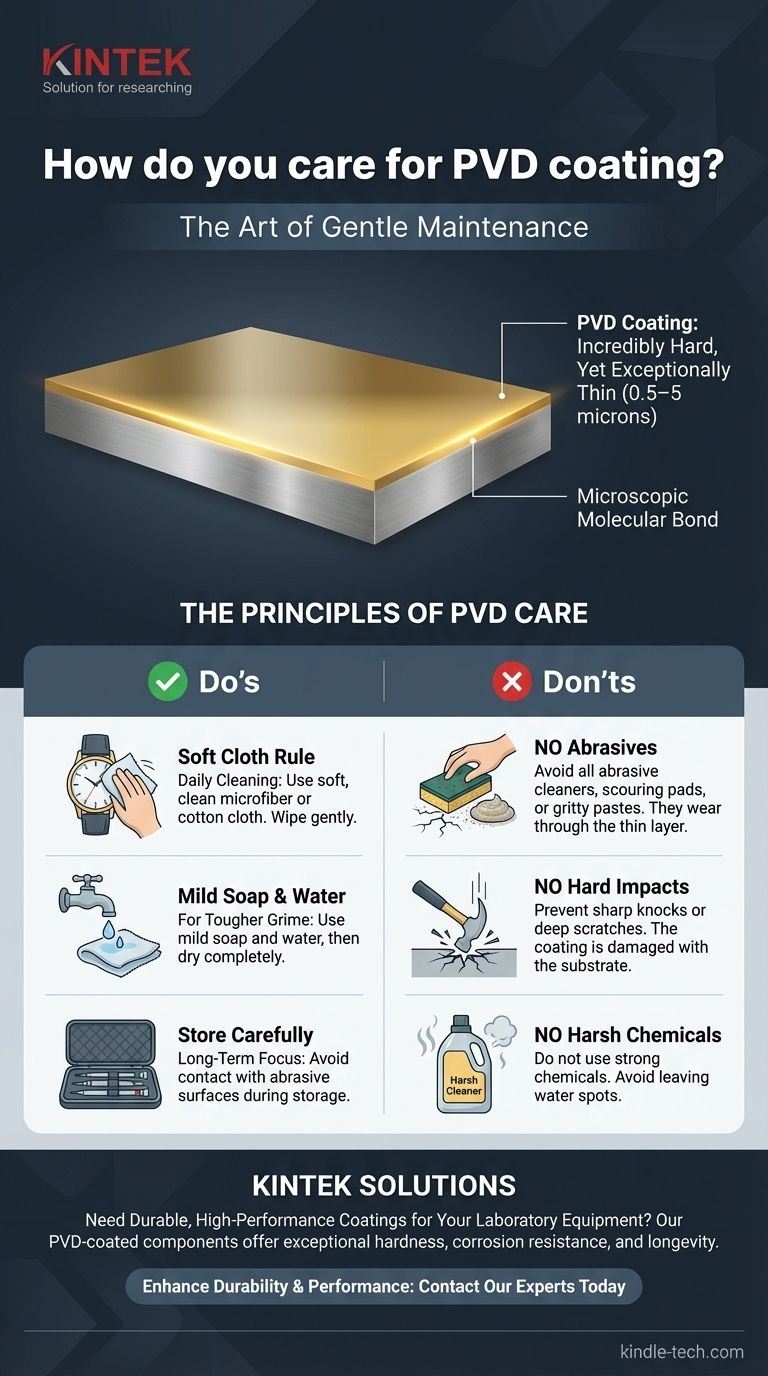To care for a PVD coating, you should perform daily cleaning with a soft, clean microfiber or cotton cloth. The goal is to avoid abrasive materials and hard impacts, as these are the primary ways to damage its otherwise highly durable surface.
The core principle of PVD care is understanding its nature: it is an incredibly hard and corrosion-resistant coating, but it is also exceptionally thin. Therefore, maintenance focuses on preserving this microscopic layer by avoiding deep scratches, harsh impacts, and abrasive friction.

What Exactly Is PVD Coating?
Physical Vapor Deposition (PVD) is a high-tech vacuum coating process. It works by vaporizing a solid metal and bonding it to a substrate material on a molecular level, creating a finish that is part of the surface itself, not just a layer on top.
The Source of Its Strength
This molecular bond is what gives PVD its renowned characteristics. The resulting surface is extremely hard—often harder than chrome—and highly resistant to scratches, corrosion, and oxidation.
An Exceptionally Thin Layer
Despite this strength, a PVD coating is microscopic, typically ranging from just 0.5 to 5 microns thick. For perspective, a single human hair is about 70 microns thick. This thinness is key to understanding why specific care is necessary.
The Principles of PVD Care
Because the protective layer is so thin, the care strategy is gentle and preventative. It’s less about intensive cleaning and more about avoiding specific types of damage.
The "Soft Cloth" Rule
For routine cleaning of fingerprints or dust, a simple wipe with a soft, dry microfiber or cotton cloth is sufficient. This removes debris without creating the micro-scratches that can dull the finish over time.
Avoiding Abrasive Materials
You must avoid all abrasive cleaners, scouring pads, or gritty pastes. While the PVD coating is very scratch-resistant, repeated rubbing with an abrasive material can eventually wear through the thin protective layer.
The Threat of Impact
PVD’s hardness resists scratches from daily wear, but it does not make the object invincible. A sharp, hard knock can still dent or gouge the underlying metal, and the coating will be damaged along with it.
Understanding the Trade-offs
PVD offers a superior finish, but it's important to recognize its limitations to care for it properly.
Durability vs. Invincibility
You gain exceptional resistance to the kind of wear that quickly degrades traditional finishes like paint or plating. The trade-off is that damage, while difficult to inflict, is often due to physical impact that cannot be polished out.
The Substrate Still Matters
The final properties of the product are influenced by the material underneath the coating. A PVD film on a soft metal will be more susceptible to dents than the same coating on hardened steel. The coating protects the surface, not the structural integrity of the base material.
A Practical Guide to PVD Maintenance
Your maintenance approach should be guided by the item's use and exposure.
- If your primary focus is daily appearance (watches, jewelry): A simple wipe with a designated microfiber cloth is all that's needed to remove skin oils and smudges.
- If your primary focus is cleaning (faucets, fixtures): Use a soft cloth with mild soap and water for tougher grime, then dry completely with another soft cloth to prevent water spots.
- If your primary focus is long-term preservation (tools, components): The absolute key is avoiding harsh impacts, drops, and contact with abrasive surfaces or chemicals.
By understanding that PVD is a micro-thin layer of strength, its simple care routine becomes both intuitive and highly effective.
Summary Table:
| PVD Care Principle | Do's | Don'ts |
|---|---|---|
| Cleaning | Use a soft, dry microfiber or cotton cloth. | Use abrasive cleaners, scouring pads, or gritty pastes. |
| Handling | Wipe gently to remove fingerprints and dust. | Subject to hard impacts, drops, or sharp knocks. |
| For Tough Grime | Use mild soap and water, then dry thoroughly. | Use harsh chemicals or allow water spots to form. |
| Long-Term Focus | Store carefully to avoid contact with abrasive surfaces. | Assume the coating makes the item invincible. |
Need Durable, High-Performance Coatings for Your Laboratory Equipment?
The proper care outlined above ensures longevity, but it all starts with a superior PVD coating. At KINTEK, we specialize in advanced lab equipment and consumables, providing PVD-coated components that offer exceptional hardness, corrosion resistance, and longevity for demanding laboratory environments. Our coatings are engineered to protect your critical tools and instruments.
Let us help you enhance the durability and performance of your lab equipment.
Contact our experts today to discuss your specific needs and discover the KINTEK difference in quality and reliability.
Visual Guide

Related Products
- Custom CVD Diamond Coating for Lab Applications
- RF PECVD System Radio Frequency Plasma-Enhanced Chemical Vapor Deposition RF PECVD
- Vacuum Hot Press Furnace Machine for Lamination and Heating
- Split Chamber CVD Tube Furnace with Vacuum Station Chemical Vapor Deposition System Equipment Machine
- 1400℃ Controlled Atmosphere Furnace with Nitrogen and Inert Atmosphere
People Also Ask
- What is the process of CVD diamond coating? Grow a Superior, Chemically-Bonded Diamond Layer
- Is diamond coating worth it? Maximize Component Life and Performance
- What is CVD diamond coating? Grow a Super-Hard, High-Performance Diamond Layer
- What are diamond coated films? Enhance Materials with Super-Hard, Transparent Layers
- What are the three types of coating? A Guide to Architectural, Industrial, and Special Purpose



















